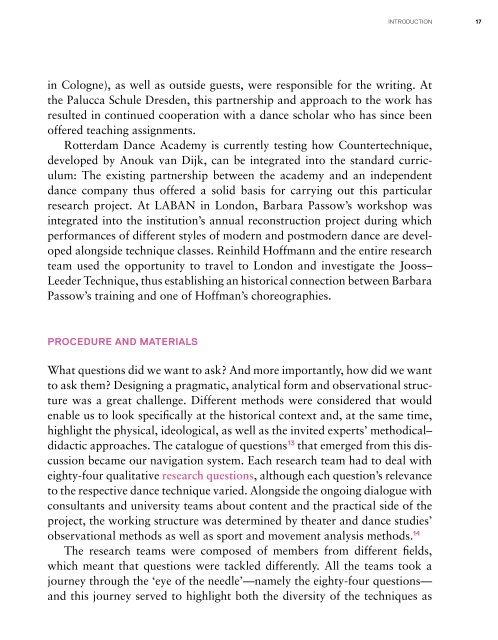Dance Techniques 2010
What does today's contemporary dance training look like? Seven research teams at well known European dance universities have tackled this question by working with and querying some of contemporary dance s most important teachers: Alan Danielson, Humphrey/Limón Tradition, Anouk van Dijk, Countertechnique, Barbara Passow, Jooss Leeder Technique, Daniel Roberts Cunningham Technique, Gill Clarke Minding Motion, Jennifer Muller Muller Technique, Lance Gries Release and Alignment Oriented Techniques. This comprehensive study includes interviews, scholarly contributions, and supplementary essays, as well as video recordings and lesson plans. It provides a comparative look into historical contexts, movement characteristics, concepts, and teaching methods. A workbook with two training DVDs for anyone involved in dance practice and theory. Ingo Diehl, Friederike Lampert (Eds.), Dance Techniques 2010 – Tanzplan Germany. With two DVDs. Berlin: Henschel 2011. ISBN 978-3-89487-689-0 (Englisch) Out of print.
What does today's contemporary dance training look like? Seven research teams at well known European dance universities have tackled this question by working with and querying some of contemporary dance s most important teachers: Alan Danielson, Humphrey/Limón Tradition, Anouk van Dijk, Countertechnique, Barbara Passow, Jooss Leeder Technique, Daniel Roberts Cunningham Technique, Gill Clarke Minding Motion, Jennifer Muller Muller Technique, Lance Gries Release and Alignment Oriented Techniques.
This comprehensive study includes interviews, scholarly contributions, and supplementary essays, as well as video recordings and lesson plans. It provides a comparative look into historical contexts, movement characteristics, concepts, and teaching methods. A workbook with two training DVDs for anyone involved in dance practice and theory.
Ingo Diehl, Friederike Lampert (Eds.), Dance Techniques 2010 – Tanzplan Germany. With two DVDs. Berlin: Henschel 2011. ISBN 978-3-89487-689-0 (Englisch) Out of print.
You also want an ePaper? Increase the reach of your titles
YUMPU automatically turns print PDFs into web optimized ePapers that Google loves.
Introduction<br />
17<br />
in Cologne), as well as outside guests, were responsible for the writing. At<br />
the Palucca Schule Dresden, this partnership and approach to the work has<br />
resulted in continued cooperation with a dance scholar who has since been<br />
offered teaching assignments.<br />
Rotterdam <strong>Dance</strong> Academy is currently testing how Countertechnique,<br />
developed by Anouk van Dijk, can be integrated into the standard curriculum:<br />
The existing partnership between the academy and an independent<br />
dance company thus offered a solid basis for carrying out this particular<br />
research project. At LABAN in London, Barbara Passow’s workshop was<br />
integrated into the institution’s annual reconstruction project during which<br />
performances of different styles of modern and postmodern dance are developed<br />
alongside technique classes. Reinhild Hoffmann and the entire research<br />
team used the opportunity to travel to London and investigate the Jooss–<br />
Leeder Technique, thus establishing an historical connection between Barbara<br />
Passow’s training and one of Hoffman’s choreographies.<br />
Procedure and materials<br />
What questions did we want to ask? And more importantly, how did we want<br />
to ask them? Designing a pragmatic, analytical form and observational structure<br />
was a great challenge. Different methods were considered that would<br />
enable us to look specifically at the historical context and, at the same time,<br />
highlight the physical, ideological, as well as the invited experts’ methodical–<br />
didactic approaches. The catalogue of questions 13 that emerged from this discussion<br />
became our navigation system. Each research team had to deal with<br />
eighty-four qualitative research questions, although each question’s relevance<br />
to the respective dance technique varied. Alongside the ongoing dialogue with<br />
consultants and university teams about content and the practical side of the<br />
project, the working structure was determined by theater and dance studies’<br />
observational methods as well as sport and movement analysis methods. 14<br />
The research teams were composed of members from different fields,<br />
which meant that questions were tackled differently. All the teams took a<br />
journey through the ‘eye of the needle’—namely the eighty-four questions—<br />
and this journey served to highlight both the diversity of the techniques as


















